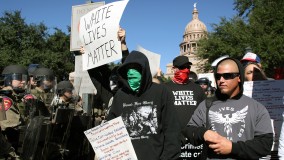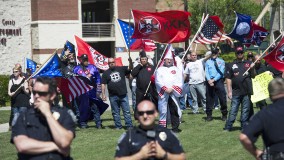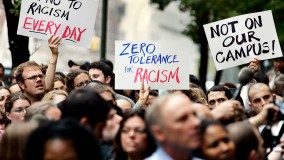Hate Crimes, Explained
The starting point for understanding hate crimes and their impact is to recognize that criminal activity motivated by bias is different from other criminal conduct. First, these crimes occur because of the perpetrator’s bias or animus against the victim on the basis of actual or perceived status. The victim’s race, religion, ethnicity, gender, gender identity, sexual orientation or disability is the reason for the crime. In the vast majority of these crimes, absent the victim’s personal characteristics, no crime would occur at all.
Second, because hate violence is intentionally and specifically targeted at individuals because of their personal, immutable characteristics, they are very personal crimes with particular emotional and psychological impacts on the victim – and the victim’s community. Hate crimes physically wound and may effectively intimidate other members of the victim’s community, leaving them feeling terrorized, isolated, vulnerable and unprotected by the law. By making the victim’s community fearful, angry and suspicious of other groups – and of the power structure that is supposed to protect them – these incidents can damage the fabric of our society and fragment communities.
We can’t address our nation’s hate crime problem without measuring it accurately. The FBI has been collecting hate crime data as part of its Uniform Crime Reporting (UCR) system since 1991 and provides the best national snapshot of the issue. Unfortunately, reporting is not mandatory, and, year in and year out, the data is clearly incomplete. In its most recent report, covering 2023, the FBI documented 11,862 hate crimes, reported by more than 16,000 law enforcement agencies across the country. However, according to national surveys conducted by the U.S. Department of Justice’s Bureau of Justice Statistics (BJS), almost 250,000 hate crimes occurred each year between 2005 and 2019. The BJS bases its estimate not on the UCR data collected from law enforcement agencies but rather on its annual National Crime Victimization Survey, which samples about 95,000 households. The actual number of hate crimes is likely somewhere between the BJS estimate and the number reported by the FBI.
As defined by the FBI, a hate crime is a violent or property crime – such as murder, arson, assault or vandalism – that is “motivated in whole or in part by an offender’s bias against a race, religion, disability, sexual orientation, ethnicity, gender or gender identity.” In addition to the federal statutes, 46 states and the District of Columbia have hate crime laws. These laws differ in significant ways. All cover bias based on race, ethnicity or religion, but many do not include gender, disability, sexual orientation or gender identity. Arkansas, Indiana, South Carolina and Wyoming do not have hate crime laws but still report hate crime data to the FBI.
The FBI releases a hate crime report each year, but it vastly understates the extent of the problem for several reasons. First, hate crime reporting by law enforcement agencies (like the entire FBI crime reporting system) is voluntary. In 2023 (the most recent data released), 80% of the 16,009 agencies that reported data to the FBI reported zero hate crimes – including about 60 agencies serving populations over 100,000. More than 2,000 other jurisdictions did not report any data. Second, according to the BJS, in almost half of all hate crimes, victims never report the crime to the police. Reporting is a two-way street: Officers must be trained to identify, report and respond to hate crimes – and victims will only report if they trust the police and believe officials will respond effectively.

In its most recent report, the FBI reported 11,862 hate crimes against persons, institutions and property in 2023, compared to 11,634 reported in 2022, a slight increase and the highest number ever reported since the FBI began collecting this data in 1991.
Of the 11,862 hate crimes reported in 2023:
- 5,900 were on the basis of race.
- 3,027 against Black people.
- 812 against Latinx people (the highest ever recorded).
- 422 against Asian American and Pacific Islanders.
- 123 against Arab Americans (the highest ever recorded).
- 2,699 were on the basis of religion.
- 1,832 against Jewish people (the highest ever recorded).
- 236 against Muslims.
- 2,077 on the basis of sexual orientation (the highest ever recorded).
- 492 on the basis of gender identity (the highest ever recorded).

Every year since 1991, the FBI has documented that racial bias has been the motivating factor in most hate crimes. But other factors involving the psychology of the offender have also been the subject of research. In one study widely used by law enforcement, sociologists Jack McDevitt and Jack Levin classified hate offenders as having four main motivations: thrill-seeking, defensive, retaliatory and mission.
- “Thrill-seeking” motivates 66% of hate crimes. These offenders are simply looking for excitement; more than 90% do not know their victims.
- “Defensive” hate crimes (25%) are committed by perpetrators who rationalize their attacks by identifying some sort of threat to themselves, their identities or their community.
- In “retaliatory” attacks (8%), culprits are acting in response to a real or perceived hate crime either to themselves or to their country. Examples include crimes committed against Muslims after the 2015 San Bernardino, California, terrorist attack.
- “Mission” hate crimes (1%) are committed by offenders who make a career out of hate. They often write at length about their hate and have elaborate, premeditated plans of attack.

Hateful speech – often intended to degrade, intimidate or incite violence or discrimination against certain groups – is harmful but likely protected by the First Amendment and not punishable under criminal law. However, the First Amendment does not protect violence or true threats of violence, nor does it prevent the government from imposing criminal penalties for violent discriminatory conduct intentionally directed against victims based on their personal characteristics.
Americans are free to think, preach and believe whatever they want. Only when an individual commits a crime and intentionally targets a person for violence or vandalism because of their own bias can a hate crime statute be triggered. Of course, racial, antisemitic or anti-LGBTQ+ slurs – or other speech that vilifies a targeted group – can be evidence of a hate crime when used by someone while committing an underlying crime.

Differentiating terrorist attacks from hate crimes is essential to understanding motive, addressing the root causes of an offense and prosecuting the offenders. Hate crimes are motivated at least in part by an offender’s personal bias and are disproportionately committed by nonpolitical youths, acting alone, not under the direction of an organized hate group, often simply for the thrill of it. Terrorist attacks, on the other hand, are violent acts inspired primarily by extremist beliefs and intended as political or ideological statements. In some cases, perpetrators target individuals or institutions associated with a specific identity – such as Jewish people or Muslims, as in a hate crime. In other cases, offenders target government installations or groups of civilians related more by proximity than by their individual identity.
Sometimes, a violent crime can be considered both a hate crime and a terrorist attack. An example is the 2015 massacre of nine Black people at a church in Charleston, South Carolina, by a young white supremacist. For the most part, though, terrorist attacks are not included in tabulations of hate crimes.

For much of U.S. history, local law enforcement officials – especially in the Jim Crow South – simply refused to investigate or prosecute lynchings and other race-based crimes. Recognizing this fact, as part of the Civil Rights Act of 1968 Congress enacted 18 U.S.C. §245 (Violent Interference with Federally Protected Rights) to prosecute a number of white supremacists who committed murders, bombings or other acts of violence to intimidate the Black community and civil rights activists. This law made it a federal crime to forcefully injure, intimidate or interfere with someone – on the basis of their race, color, religion or national origin – because of their attempt to participate in any of six federally protected activities, including voting or attending school.
In 1990, Congress passed the Hate Crime Statistics Act. It required the attorney general to publish an annual report on crimes that exhibit evidence of prejudice based on race, religion, sexual orientation or ethnicity. The FBI was tasked with collecting and reporting this data under its UCR program, which has been gathering crime data from state and local law enforcement agencies on a voluntary basis since 1930.
Upon the passage of the Hate Crime Statistics Act, President George H.W. Bush referenced the Civil Rights Memorial, built and sponsored by the SPLC in Montgomery, Alabama. Bush quoted Martin Luther King Jr., whose words are etched on the memorial: “We will not be satisfied until justice rolls down like waters and righteousness like a mighty stream.” Bush added, “We must rid our communities of the poison we call prejudice, bias and discrimination. … The Hate Crime Statistics Act is an important further step toward the protection of all Americans’ civil rights.”
In 1994, the Violent Crime Control and Law Enforcement Act amended the Hate Crime Statistics Act to include bias against persons with disabilities.
The Church Arson Prevention Act of 1996 cemented the Hate Crime Statistics Act by making the collection of hate crime data a permanent part of the UCR program. Enacted after 66 Black churches were destroyed in less than two years, the act provided added authorization for the federal government to prosecute people who burn or damage religious property.
In 2009, Congress passed the landmark Matthew Shepard and James Byrd Jr. Hate Crimes Prevention Act [Division E of the National Defense Authorization Act for FY 2010], named for two victims of horrific crimes based partly or wholly on their identities. Matthew Shepard, a 21-year-old gay student, was beaten and murdered in Wyoming. James Byrd Jr., a 49-year-old Black man, was dragged to his death behind a truck by three white supremacists in Texas.
The Shepard-Byrd Act changed federal hate crime law in several important ways. It removed the requirement that to qualify as a hate crime, the victim must have been participating in a federally protected activity such as voting. It expanded the existing hate crime law to include crimes motivated by a victim’s actual or perceived gender, sexual orientation, gender identity or disability. It required the FBI to add gender and gender identity as categories of hate crimes it tracks. It gave the federal government greater flexibility to prosecute hate crimes that local authorities choose not to pursue. And it required the FBI to collect data concerning hate crimes committed by or targeting juveniles. The FBI began collecting this data in 2013.
In 2015, the FBI expanded the religious bias category and began collecting and reporting on hate crimes directed against, among other groups, Sikhs, Hindus, Arabs, Mormons, Jehovah’s Witnesses and Eastern Orthodox people.
The vast majority of hate crimes today are investigated and prosecuted by state and local law enforcement officials. Yet, as mentioned, four states do not have hate crime laws. In addition, only 33 states and D.C. cover sexual orientation; only 32 states and D.C. cover gender; only 23 states and D.C. cover gender identity/expression; and only 34 states and D.C. cover disability. The Shepard-Byrd Act serves as an essential backstop when state or local law enforcement officials either cannot or will not investigate and prosecute a hate crime.
Enactment of the COVID-19 Hate Crimes Act in May 2021, which included the provisions of the Khalid Jabara and Heather Heyer National Opposition to Hate, Assault and Threats to Equality Act (NO HATE Act) in Section 5, was an important step forward. That law – sparked by thousands of incidents of violence, harassment and intimidation directed against Asian American and Pacific Islander people – authorized incentive grants to stimulate improved local and state hate crime training, prevention, best practices and data collection initiatives. The law also authorized grants available for state hate crime reporting hotlines to direct individuals to local law enforcement and support services. The Justice Department announced after the law was enacted, and, in conjunction with the Department of Health and Human Services, published a community guide designed to raise awareness of rights and build resilience in the aftermath of hate incidents.

After Jeanne Clery was raped and murdered in her dorm room in 1986, The Clery Act of 1990 was created to increase awareness of crime on college campuses. The act requires all colleges that receive federal funding to share information about campus crime – including hate crime – with their students and employees. These institutions must report how they address safety on campus, inform the public about campus crime and reduce crime rates. Colleges must also report the ways in which they are working to remedy situations with victims and include prevention education in their policies. A 2008 amendment to the Clery Act requires postsecondary institutions to report hate crime incidents. The U.S. Department of Education publishes the number of hate crimes reported by these institutions annually. The Department recently announced that it would begin collecting more specific hate crime data from covered institutions.

Hate crime data reporting is incomplete for many reasons. As previously mentioned, only a fraction of the more than 18,000 federal, state, local and tribal law enforcement agencies reported even a single hate crime to the FBI in 2023. Many agencies lack the training to identify, report and respond to hate crimes. Only 19 states have laws requiring that officers be trained to identify and investigate hate crimes. Numerous police departments also have misconceptions about handling hate crimes. According to a national survey by ProPublica, many agencies wrongly believe it is up to prosecutors to deem an incident a hate crime. In fact, state law definitions of what constitutes a hate crime are irrelevant for FBI data collection purposes, as outlined in their comprehensive Hate Crime Data Collection Guidelines and Training Manual. And, though the FBI itself has begun reporting hate crimes, many federal law enforcement agencies – and the military service branches – do not.

Absolutely. Much more needs to be done to improve data collection – and to prevent hate crimes from occurring in the first place.
Data drives policy
We cannot remedy our nation’s hate crime problem without accurate information about the nature and magnitude of the problem. New bipartisan legislation, the Improving Reporting to Prevent Hate Act, would condition federal funding for large law enforcement agencies (those serving jurisdictions over 100,000 in population) on credible hate crime reporting to the FBI – or meaningful hate crime prevention, outreach and awareness initiatives by such agencies. Improving data collection requires that targeted people report hate crimes against them and that well-trained police knowing how to identify, report and respond to hate violence. Research has shown that better hate crime data would help to properly allocate police resources and personnel – preventing crimes, reassuring hate crime survivors, and building trust and relationships between law enforcement and the communities they serve.
Importantly, significant organizations in the law enforcement community have elevated their voices in support of more comprehensive hate crime data collection. In March 2021, the International Association of Chiefs of Police updated its Model Policy and Concepts and Issues Paper on Hate Crime – adding mandatory hate crime reporting for the first time as a best practice. And the National Police Foundation’s Open Data Initiative has demonstrated conclusively the police-community relations benefits of credible, publicly accessible, real-time hate crime data.
Prevention is better than enforcement
The law is a blunt instrument to confront hate and extremism. It does not address the disparate root causes of hate, nor does it adequately mitigate future harms to historically targeted and marginalized communities. Enforcement of existing federal and state hate crime laws – and training for judges, prosecutors and law enforcement officials charged with enforcement – is critical but insufficient. Simply put, we cannot legislate, regulate, tabulate or prosecute racism, hatred or extremism out of existence.
We are living in a time when several states, particularly in the South, are enacting laws that restrict teaching about racism and other painful truths about our national history. Concealing the truth about our history does not protect young people; it makes them susceptible to misinformation and fails to equip them with the critical thinking skills and education they need to navigate a new age where disinformation and manipulation are spreading on the internet. Much more needs to be done to teach young people the unvarnished truth about U.S. history – both good and bad – so that they can learn lessons from the past to shape a better future.
Congress and the administration should promote inclusive education and democracy-building school initiatives that celebrate our nation’s diversity – and fiercely oppose laws and policies that prevent educators from teaching truth and hard history, and other efforts to restrict inclusive education.

The issues with underreporting are not the only ones creating obstacles to addressing hate crimes in the U.S. The difficulty with prosecution is also an issue. According to the Bureau of Justice Statistics, violent hate crimes are three times less likely to result in an arrest than violent crimes not related to bias. In the vast majority of hate crime cases, the victim does not know the offender.
Hate crimes are difficult to prosecute in part because of the evidence needed to result in a conviction. Prosecutors must prove the underlying crime beyond reasonable doubt and convince jurors that the offender was motivated by bias. Without hate speech accompanying the crime, it is a difficult hurdle.
When states do not have the necessary resources or authority to prosecute a hate crime, the process is even more arduous. The Shepard-Byrd Act allows the federal government to prosecute hate crimes in some cases where local or state prosecutors are either unable or unwilling to act. However, before the DOJ may prosecute a hate crime, several criteria must be met. The U.S. attorney general must assert that either the state does not have jurisdiction, that the state asks the federal government to assume jurisdiction, that a verdict or sentence obtained under state charges insufficiently eradicates bias-motivated violence, or that it is in the public interest of the United States to prosecute. Hence, federal hate crime prosecutions are rare. A July 2021 BJS report found that, from Oct. 1, 2004, to Sept. 30, 2019, U.S. attorneys investigated 1,864 suspects accused of violating federal hate crime laws, with just 17% of the suspects later referred for prosecution.

The administration and Congress must take meaningful actions that prioritize combating all forms of hate, promoting mutual respect and understanding, and ensuring that all people in America, regardless of their background, feel protected and valued.
- After more than 30 years of incomplete data and consistent underreporting, Congress should expand incentives – more carrots and more sticks – toward making hate crime reporting mandatory. Congress should enact HR 7648, bipartisan legislation that would condition federal funding for large police agencies on reporting credible hate crime data to the FBI – or meaningful community hate crime prevention and awareness initiatives.
- At the United We Stand Summit in September 2022, the White House announced a wide array of very welcome government initiatives, along with several public-private partnerships, designed to foster unity and build community trust and resilience in the fight against hate and extremism. To fulfill the full promise of the Summit, the Biden administration should work with Congress to ensure adequate funding for these programs and initiatives.
- We applaud the Justice Department’s United Against Hate Initiative. Each of the 94 U.S. attorneys should promote comprehensive hate crime reporting for all cities in their jurisdictions. Every U.S. Attorney’s Office should designate a person or team to lead hate crime prevention and response – to enable community-based organizations to have a point of contact.
- Congress should provide funding for the Justice Department’s Civil Rights Division to investigate and prosecute hate crimes – and more funding for the Community Relations Service to hire new professionals to help mediate, train and facilitate in communities with intergroup tensions and in the aftermath of hate crimes.
- Very significant Department of Homeland Security FEMA federal funding and other state funding is now devoted to increasing security and hardening of houses of worship and other at-risk community institutions. Those funds must be complemented by sufficient resources devoted to addressing root causes and preventing hate and extremism.
- Federal agencies, including the Department of Justice, the Department of Education and the Department of Health and Human Services, should establish and fund programs to build community resiliency against hate, to inoculate against extremism, and to empower adults to help steer young people away from violent extremism. The work the SPLC is doing with American University’s Polarization and Extremism Research and Innovation Lab (PERIL) to promote age-appropriate public health approaches to prevent exposure to radicalization content provides a valuable model and resources.
- Federal, state, and local police officers are not immune from extremist ideologies that have been mainstreamed in recent years. But individuals tasked with protecting the public equitably cannot be trusted to do so if they associate with an openly racist, bigoted or misogynistic organization. Congress should address white supremacy in federal law enforcement by enacting legislation to require the Department of Homeland Security, the Department of Justice and the FBI – and all other federal agencies with law enforcement responsibility – to promptly “avoid the hiring and retention of law enforcement officers who promote unlawful violence, white supremacy or other bias against persons based on race, ethnicity, national origin, religion, sex [including sexual orientation and gender identity], or disability ” as mandated in President Biden’s May 2022 police reform executive order.
- The Department of Education should fund programs aimed at preventing extremism and promoting deradicalization – and move from punishment models to restorative justice initiatives that build community resilience. Funding should also be provided to promote civics education and develop curricula on structural racism, as well as funding for states to implement their own related initiatives.
- Under the Clery Act, colleges and universities are required to report campus hate crimes to the Department of Education, yet very substantial gaps in reporting exist. The administration and Congress should ensure that colleges and universities are prioritizing the safety of their students, including comprehensive hate crime reporting to the Department of Education.
- Consistent with the First Amendment and privacy considerations, the administration and Congress should adopt rules and regulations to ensure that tech companies increase accountability and transparency and comply with civil rights laws prohibiting discrimination.
- We should provide incentives for tech companies to create and enforce policies and terms of service to ensure that social media networks, payment service providers and other internet-based services do not provide platforms for hateful activities and extremist content.
- Federal and state authorities should aggressively enforce civil and criminal provisions that address hate crimes in their Fair Housing laws.
Additional contributions to this essay were made by Swathi Shanmugasundaram.
Photo at top by STRF/STAR MAX/IPx/AP Images
